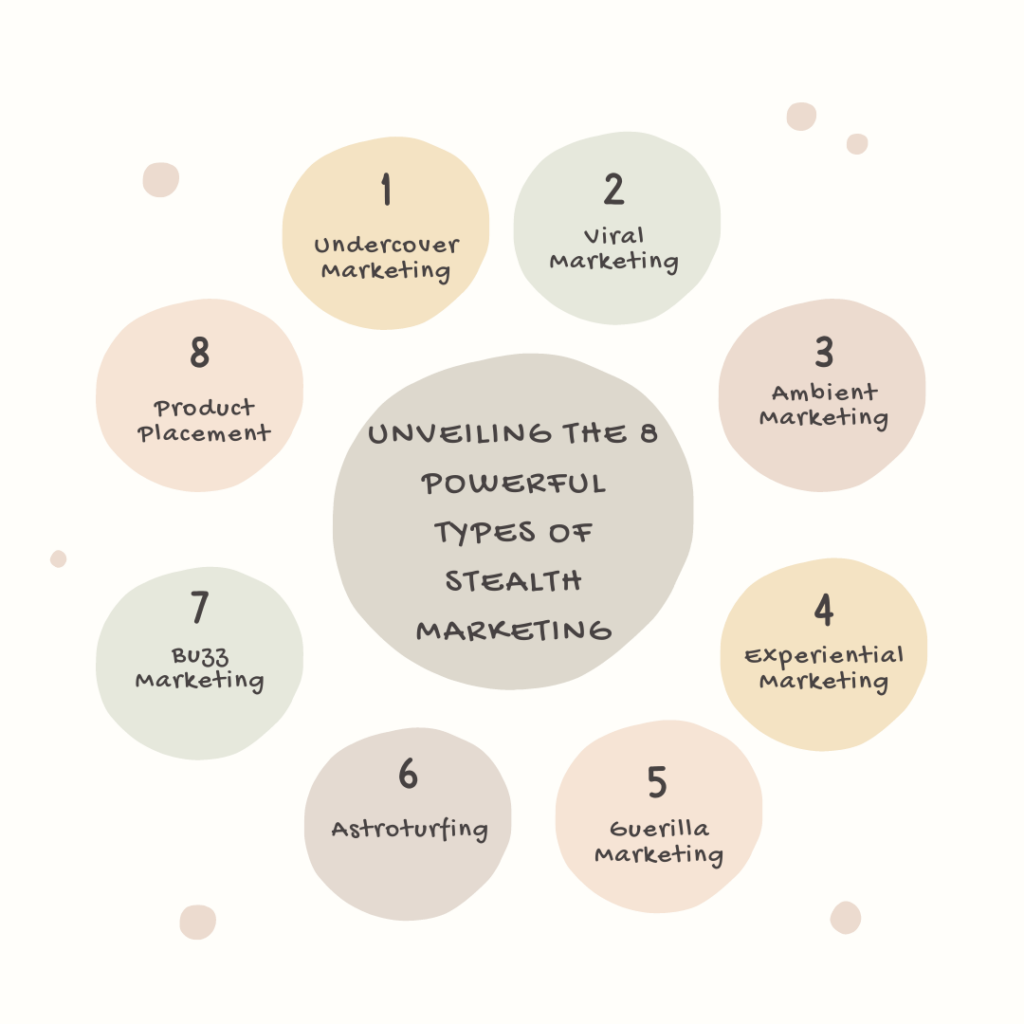Stealth Marketing, also known as undercover or buzz marketing, refers to any marketing strategy that advertises a product to people without them realizing they are being marketed to. This concept is derived from the stealth technology that is designed to avoid detection using a variety of technologies that minimize radar, infrared, sonar and other detections.
Stealth marketing could be executed through several strategies such as viral marketing, product placements, undercover marketing, brand pushers, and astroturfing. In viral marketing, for instance, marketers develop videos or other digital content that consumers share via social media. Product placement is a strategy where companies skillfully place their products in films or television series, hoping that viewers would notice and feel inclined to purchase the products.
The Importance of Stealth Marketing in Business
Modern consumers are saturated with overt advertisements and often develop ad blindness, ignoring, or avoiding obvious advertising messages. Thus, marketers have shifted towards subtler forms of advertising – stealth marketing being one of them. Stealth marketing has several key importance in business:
Bypassing Advertising Clutter: Stealth marketing can cut through the clutter of traditional advertising. This is crucial in an age where consumers are constantly bombarded with overt advertising messages. Stealth marketing can effectively reach the target audience without any apparent ‘hard-selling’.
Consumer Engagement: By disguising the marketing message in entertaining or engaging content, stealth marketing can generate more customer engagement and interaction than traditional advertising methods. The intrigue and mystery created around the product ignite curiosity, increasing the likelihood of the consumer engaging with the product.
Building Trust: Stealth marketing often involves indirect recommendations by influencers or peers, which can create a sense of authenticity and trust. This can influence consumer decisions more effectively than direct advertising, as consumers often trust recommendations from peers over conventional advertising.
Cost-Effective: Stealth marketing strategies such as viral marketing or product placements often require less financial investment than traditional advertisement but can reach a larger audience if executed effectively. This makes stealth marketing a cost-effective alternative.
The Psychological Aspects of Stealth Marketing
Stealth marketing, commonly known as undercover marketing, is a strategy where consumers are marketed to without them being aware that they are being marketed to. This strategy leverages psychological principles to influence consumer behavior subtly.

The Principle of Authority: This psychological principle states that people tend to obey figures of authority. Stealth marketing often incorporates celebrities or influencers who have authority in the eyes of the consumer. For example, a celebrity might be photographed using a product, and this image is shared on social media. The consumers, seeing someone they admire using the product, may be more inclined to purchase it.
The Principle of Social Proof: Humans are social creatures and tend to follow the crowd. Stealth marketing uses this principle by creating situations where it appears that many people are using a product or service. This could be done through viral marketing campaigns or influencer marketing on social media platforms.
The Principle of Reciprocity: This principle suggests that people feel obliged to give when they receive. In stealth marketing, a company might give away samples of a product, causing the recipient to feel a sense of obligation to purchase or promote the product.
The Principle of Scarcity: This principle suggests that items are more attractive when their availability is limited. Stealth marketing can exploit this by creating ‘limited edition’ products or ‘flash sales.’
The Impact of Stealth Marketing on Consumer Behavior
Stealth marketing can have significant impacts on consumer behavior. These impacts are often positive from a business perspective, driving sales and brand awareness, but they can also be negative if consumers feel deceived.
Increased Brand Awareness and Sales: Stealth marketing can increase brand awareness and sales. For instance, a study on the impact of influencer marketing (a form of stealth marketing) found that for every dollar spent on influencer marketing, businesses made $6.50 in return (Tomoson, 2015).
Enhanced Perception of Authenticity: Stealth marketing can enhance the perception of authenticity. This is because consumers are more likely to trust recommendations from individuals within their social circles than traditional advertisements.
Risk of Consumer Backlash: If consumers discover they have been targets of stealth marketing, they may feel manipulated and react negatively. This can lead to a damaged brand reputation and possibly reduced sales.
Ethical Implications: Stealth marketing raises ethical questions about consumer manipulation and deception. Some argue that it infringes on a consumer’s right to know when they are being marketed to.
Unveiling the 8 Powerful Types of Stealth Marketing

Undercover Marketing: Also known as stealth marketing, it involves marketing in a way that the audience does not realize they are being marketed to. This could involve hiring actors to subtly promote a product in public or creating unbranded viral content. In-depth research would be required to design an effective campaign and analyze its impact. We would need to track metrics such as audience reach, engagement, and conversion rates.
Viral Marketing: This form of marketing involves creating content that spreads rapidly online, often through social media. It capitalizes on the high-speed and wide reach of the internet. Research would involve analyzing trends and viral factors, creating and disseminating content, and tracking its spread and impact. The success of such campaigns can be quantified through views, shares, likes, comments, and the rate of content spread.
Ambient Marketing: This strategy aims to incorporate advertising into the environment in a way that does not interrupt the audience’s activities. Examples could be adverts on shopping carts, benches, or floors. Research into ambient marketing would involve studying how such adverts impact consumer behavior and perception. Survey-based research methods could be used to gather data, which can then be statistically analyzed.
Experiential Marketing: This is a strategy that engages the audience through experiences that involve the product or brand. It could be a pop-up shop, a virtual reality experience, or a themed event. Research would involve studying the impact of these experiences on brand perception, engagement, and loyalty. Data could be gathered through surveys, interviews, and observation, and analyzed using descriptive and inferential statistics.
Guerilla Marketing: This involves unconventional, surprise elements designed to catch the audience off-guard and create a strong impression. It often involves street art, flash mobs, or surprise events. Research would involve studying the impact of such surprise elements on brand recognition and recall. Experimental research methods could be employed to compare the impact of guerilla marketing with traditional methods.
Astroturfing: This involves creating the illusion of grassroots support for a product or cause, usually through fake reviews, testimonials, or social media accounts. Research into astroturfing would involve studying its prevalence, impact on consumer trust and brand reputation, and methods of detection. Data mining techniques could be used to gather and analyze data from online sources.
Buzz Marketing: This strategy involves creating ‘buzz’ or excitement around a product, usually through influencers, events, or pre-launch teasers. Research would involve studying the impact of buzz on sales, brand recognition, and consumer anticipation. Data could be gathered through sales figures, social media metrics, and surveys, and analyzed using time-series analysis and regression models.
Product Placement: This involves integrating the product into a TV show, movie, video game, or other media content. Research would involve studying the impact of product placement on brand recognition, recall, and perception. Experimental research methods could be used to compare the impact of product placement with traditional advertising.
A Closer Look at Successful Stealth Marketing Campaigns
The Blair Witch Project (1999)
In this stealth marketing campaign, the filmmakers created a narrative about a haunted forest and a group of film students who disappeared. They used a low-budget film, a website, and word-of-mouth marketing to generate buzz. The result was a box office success that generated $248.6 million worldwide from a modest budget of approximately $60,000, a return on investment of over 400,000%.

Campaign: “Red Bull Stratos (2012)“
Red Bull sponsored a high-altitude skydiving project called Stratos, where Felix Baumgartner jumped from space to Earth. Red Bull subtly promoted its brand during the event, resulting in an estimated worldwide audience of over 8 million people live on YouTube. The event was reported to have increased Red Bull’s sales by 7% in six months.

Campaign: “Ikea’s Sleepover (2011)“
Ikea UK responded to a Facebook group of 100,000 members requesting a sleepover at Ikea. The company allowed 100 fans to spend the night in one of their warehouses. The event included manicures, massages, bedtime stories, and the chance to win Ikea products. The resulting campaign went viral and garnered positive media attention.

Stealth Marketing Failures: Learning from Mistakes
Snapple’s Largest Popsicle (2005)
Snapple attempted to erect the world’s largest popsicle in New York’s Times Square. However, the 17.5-ton ice pop melted faster than expected, causing a sticky flood of kiwi-strawberry-flavored fluid that flowed onto the streets. The campaign failed due to poor planning and absence of adequate risk assessment.

Cartoon Network’s ‘Aqua Teen Hunger Force’ (2007)
To promote a new film, Cartoon Network installed LED signs in various locations around Boston. However, the signs were mistaken for explosive devices, leading to bomb scares and citywide panic. The network had to pay $2 million in damages, demonstrating the importance of understanding public perceptions and potential risks in executing stealth marketing.
Burger King’s Whopper Sacrifice (2009)
Burger King launched a Facebook application, encouraging users to ‘sacrifice’ ten friends to get a free Whopper. While the campaign initially gained traction, it faced backlash for promoting anti-social behavior and was eventually taken down by Facebook. This incident emphasizes the need for stealth marketing campaigns to align with platform rules and societal expectations.

Samrat is a Delhi-based MBA from the Indian Institute of Management. He is a Strategy, AI, and Marketing Enthusiast and passionately writes about core and emerging topics in Management studies. Reach out to his LinkedIn for a discussion or follow his Quora Page

